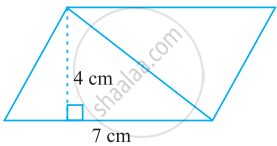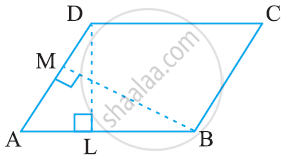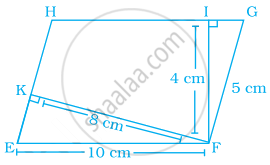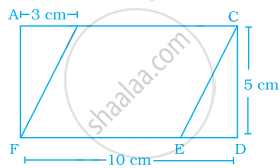Advertisements
Advertisements
प्रश्न
A square and a parallelogram have the same area. If the side of the square is 48 m and the height of the parallelogram is 18 m. Find the length of the base of the parallelogram
उत्तर
Given side of the square is 48 m
Area of the square = (side × side) sq.unit
= 48 × 48 m2
Height of the parallelogram = 18 m
Area of the parallelogram = ‘bh’ sq.units
= b × 18 m2
Also area of the parallelogram = Area of the square
b × 18 = 48 × 48
b = `(48 xx 48)/18`
= 8 × 16
= 128 m
Base of the parallelogram = 128 m
APPEARS IN
संबंधित प्रश्न
Find the area of the following parallelogram:

Find the area of the following parallelogram:

DL and BM are the heights on sides AB and AD respectively of parallelogram ABCD (see the given figure). If the area of the parallelogram is 1470 cm2, AB = 35 cm and AD = 49 cm, find the length of BM and DL.

If area of a parallelogram is 29.6 sq cm and its base is 8 cm, find its height.
The two sides of the parallelogram ABCD are 6 cm and 4 cm. The height corresponding to the base CD is 3 cm.
Find the
(i) area of the parallelogram.
(ii) the height corresponding to the base AD.

A ground is in the shape of parallelogram. The height of the parallelogram is 14 metres and the corresponding base is 8 metres longer than its height. Find the cost of levelling the ground at the rate of ₹ 15 per sq.m
The height of the parallelogram is one-fourth of its base. If the area of the parallelogram is 676 sq.cm, find the height and the base
In the given figure, EFGH is a parallelogram, altitudes FK and FI are 8 cm and 4 cm respectively. If EF = 10 cm, then area of EFGH is ______.

In the given figure, area of parallelogram BCEF is ________ cm2 where ACDF is a rectangle.

To find area, any side of a parallelogram can be chosen as ______ of the parallelogram.
